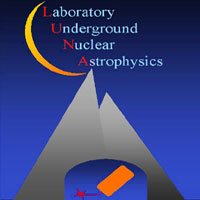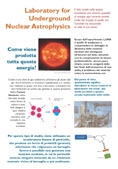
Nuclear reactions that generate energy and synthesize elements take place inside the stars in a relatively narrow energy window: the Gamow peak. In this region, which is in most cases below 100 keV, the reaction cross-section drops almost exponentially with decreasing energy. Its extremely low value has always prevented its measurement in a laboratory at the Earth’s surface, where the signal to background ratio would be too small because of cosmic ray interactions.
Instead, the observed energy dependence of the cross section at high energies is extrapolated to the low energy region, leading to substantial uncertainties.
In order to explore this new domain of nuclear astrophysics we have installed two electrostatic accelerators underground in LNGS: a 50 kV accelerator, that took data until 2001 and a 400 kV one, that was installed in 2000.
Outstanding features of both the accelerators are a very small beam energy spread and a very high beam current even at low energy. Windowless gas targets or high purity solid targets have been mounted in our set-up, whereas silicon detectors, big BGO crystals and ultra-high purity germanium detectors are being used for particle and gamma ray detection. With the 50 kV accelerator the 3He(3He,2p)4He and d(p,γ)3He reactions have been measured for the first time within the Gamow peak of the Sun. The former plays a big role in the proton-proton chain, largely affecting the calculated solar neutrino luminosity, whereas the latter is the reaction that rules the star life during its infancy.
With these measurements LUNA has shown that, by going underground and by using the typical techniques of low background physics, it is possible to measure nuclear cross sections down to the energy of the nucleo-synthesis inside stars.
One of the first and main results obtained with the 400 kV accelerator has been the low energy measurement of the 14N(p,γ)15O, the slowest reaction of the CNO cycle, the key one for the knowledge of the CNO solar neutrino flux, as well as for the determination of the age of the Globular Clusters, the oldest population of stars in the Galaxy. The results obtained at low energies both using a high resolution solid target setup and a high efficiency gas target setup, have given a cross-section reduction of about a factor 2 compared to the values used in the stellar models. As a consequence, the predicted CNO solar neutrino flux has been decreased by about a factor 2 and the age of the Globular Clusters has been increased by about 1 billion years. The new determination of the age of the Globular Clusters can also be considered as a lower limit for the age of the Universe.
The 3He(4He,α)7Be, a key nuclear reaction for Solar neutrino production has been measured at LUNA down to 93 keV with an uncertainty of 4%. The 3He(4He,α)7Be reaction cross section has been namely the largest nuclear physics source of uncertainty in predicting the solar 7Be and 8B neutrino flux.
The reaction cross section has been obtained detecting the prompt γ-rays and the delayed γ-rays from the 7Be decay at the same time, proving that no discrepancy exists between the results obtained with the two techniques, therefore reducing the uncertainty on the 3He(4He,α)7Be cross section. As a consequence the uncertainty on the prediction of the Solar neutrino flux due to nuclear physics inputs has been significantly reduced.
Webmaster
